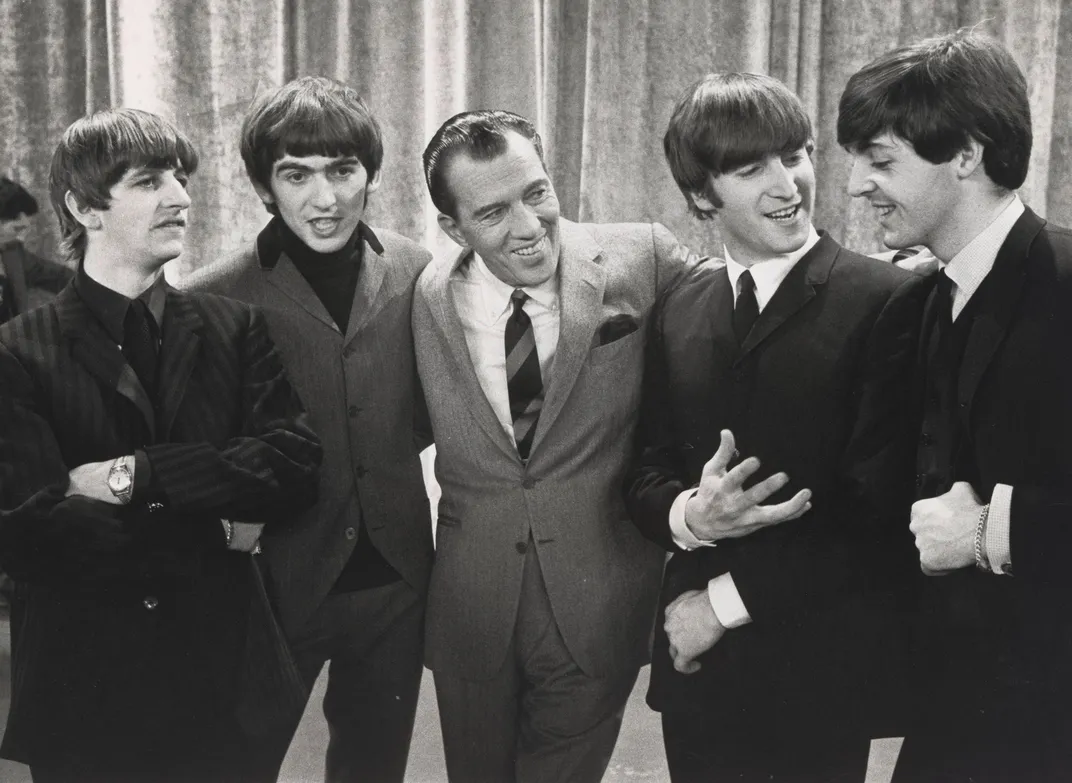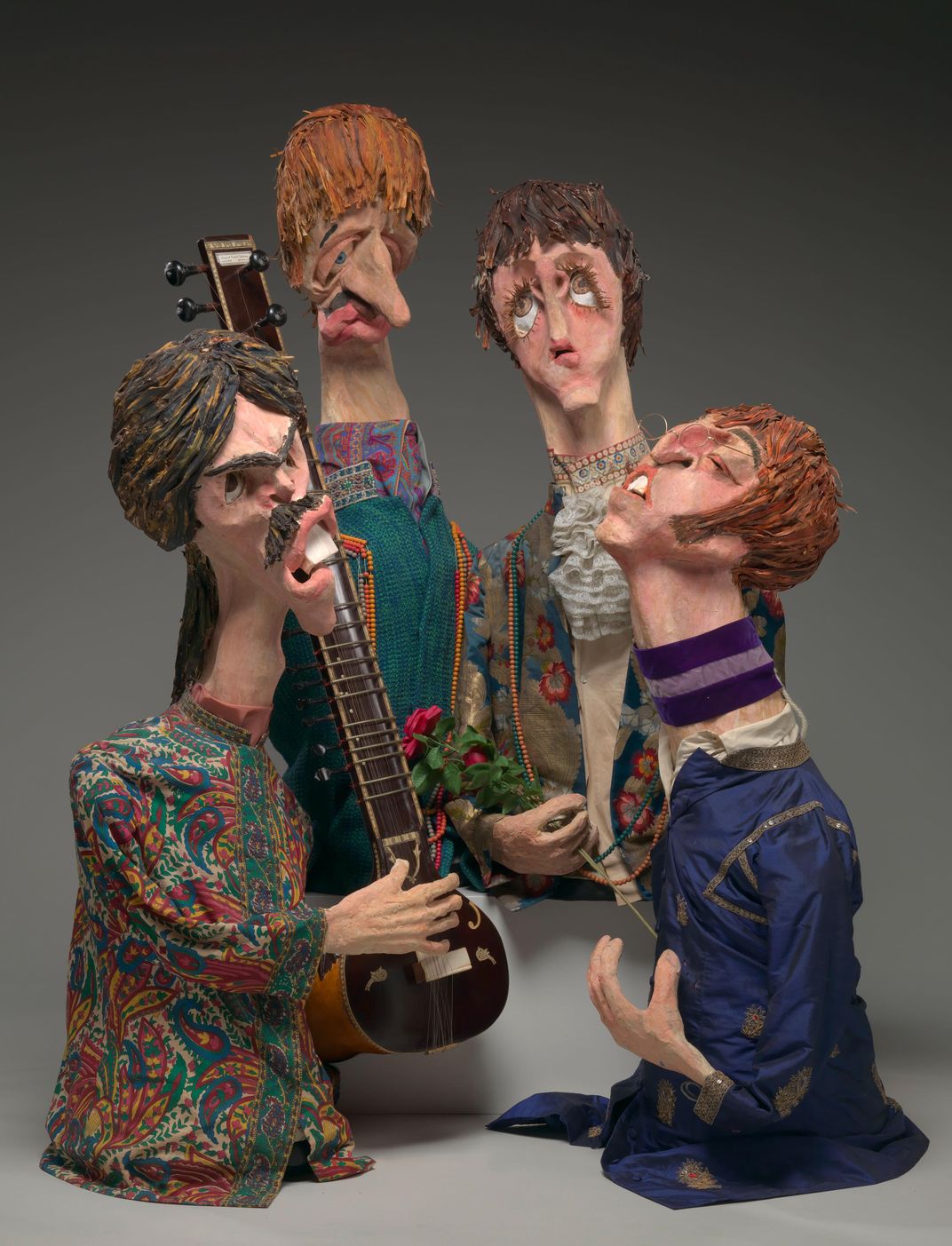“Hey Jude” Still Makes Everything “Better, Better, Better”
The Beatles’ biggest single hit skyrocketed on the charts in August of 1968
/https://tf-cmsv2-smithsonianmag-media.s3.amazonaws.com/filer/f3/67/f367011b-768a-464e-85a1-cd86f4d96df9/nmah-jn2014-4062cropped.jpg)
Decades after Beatlemania rocked the world, Paul McCartney launches into the band’s biggest single ever—“Hey Jude.” Captivated, the 21st-century crowd sways, arms waving and hands clapping to the beat. Fans hold iPhones high over their heads to capture this once-in-a-lifetime event. There is magic here. No matter what their ages, these listeners revel in the joy of the song’s uplifting chant, “Nah nah nah nah nah nah, nah nah nah. . .”
The decades-old song dwells in the musical DNA of our times. It is as deeply known as a nursery rhyme and as appealing as a cup of gelato on a steamy August day. The song’s hypnotic repetition makes some want to linger, never to let the music end. At the back of the room stands a woman with tears in her eyes as she listens to that familiar McCartney voice emerging from the now gray-haired mop-top on the stage.
This unexpected scene unfolded in 2018 in a Liverpool pub, a performance orchestrated by the late-night host James Corden for his popular YouTube show “Carpool Karaoke.” Similar moments can be found on YouTube in other years among other audiences. McCartney stands at the heart of the classic, in the hearts of his listeners. These performances create an odd mixture of the commonplace and the extraordinary. As even a performance in Red Square shows, the music has entered the fabric of daily life; however, the singer exists as anything but ordinary. He is a legend, and this tune is the most famous creation within his musical legacy.
“Hey Jude” skyrocketed to the top of the singles charts in the United States and Great Britain in 1968. After an August 26 U.S. release, it immediately arrived in the Top Ten and sat atop Billboard’s Hot 100 for nine consecutive weeks, making it the most successful single recorded by the most prosperous band in history. The single sold more than 5 million copies worldwide in six months and 7.5 million over four years. It performed more spectacularly on the charts than any other single between 1959 and 1977. It was also the first release on the Beatles’ own record label—Apple.
After McCartney’s surprise appearance in the Liverpool pub in 2018 with Corden, “Hey Jude” joined two new McCartney tunes as well as five other Beatles numbers on Billboard’s Hot Rock Songs list. During the week of June 28, 2018, 5,000 people downloaded the song.
At more than seven minutes long, “Hey Jude” remains one of the longest No. 1 singles ever. The extended coda—a repetition of “nah, nah nah nah-nah-nah nah, nah-nah-nah nah, Hey Jude”—fills the second half of the record. In all, the lyrics use the sound “nah” 240 times. In the words of John Troutman, curator of American music at the National Museum of American History, where a 45 rpm 7-inch vinyl single of the song resides in the collections, this section is both mesmerizing and ecstatic.
During the coda, McCartney provides what British music critic Ian MacDonald described as some “ill-advised pseudo-soul shrieking.” Nevertheless, MacDonald argues that the lyrics strike “a universal note, touching on an archetypal moment in male sexual psychology with a gentle wisdom one might properly call inspired.” Music critic Richie Unterberger wrote that “what could have been just another great Beatles ballad became something quite extraordinary at the end of the last verse when vocals unpredictably repeat the last word over and over again in ascending notes, ending in a full-out-jubilant scream” BETTER, BETTER, BETTER, BETTER, AY! before an extended fadeout.
“The Beatles produced so many hit singles,” says Troutman, “but in this song they seem to have struck their most resonant chord. It seems that they unleashed in ‘Hey Jude’ a perfect storm of songwriting maturity, profundity in a time of rage, and marketing fury. The song is somber yet full of hooks (‘Nah nah nah’).”

When “Hey Jude” was recorded, a 36-piece orchestra—ten violins, three cellos, three violas, two flutes, one contra bassoon, one bassoon, two clarinets, one contra bass clarinet, four trumpets, four trombones, two horns, percussion and two string basses—joined the Beatles, and all but one of the orchestra performers accepted double pay for singing and clapping during the taping. As the first recording session began, McCartney did not notice that drummer Ringo Starr had just walked out to take a bathroom break. Seconds later, he heard Starr walk behind him and return to his drums just in time for his first contribution to the performance. McCartney considered this fortuitous timing a good omen that led the other performers “to put a little more into it.” He recalled thinking: “This has got to be the take, what just happened was so magic!”
Shunning public appearances, the Beatles introduced the song to the world via film and video. The film version premiered in Britain on September 8 on David Frost’s show “Frost on Sunday,” and a month later the video version premiered October 6 in the U.S. on the “Smothers Brothers Comedy Hour.”
McCartney composed the piece during a drive in his Aston Martin from London to Weybridge, where he visited fellow Beatle John Lennon’s estranged wife Cynthia and five-year-old son Julian Lennon. McCartney has said that he conceptualized the song as a message to Julian, with “Hey Jules” offering advice to preserve Julian’s happiness as his parents faced a messy divorce over Lennon’s affair with future wife Yoko Ono. Later, he says, “I just thought a better name was Jude. A bit more country and western for me.” Julian’s dad thought McCartney’s lyrics were about his new relationship with Ono and that in a way, McCartney was giving him the go-ahead to leave their songwriting partnership and transfer his entire allegiance to his new love.
Other interpretations have surfaced. For instance, while the song’s beginning fits into McCartney’s description of his song for Jules, many other lines “seem directed more at a grown man on the verge of a powerful new love,” author Mark Hertsgaard writes. “That so many people seek to assign competing meanings to the lyrics, even with the Julian story so well-established, attests to the song's deep emotional impact as well as the lyrics' openness, even vagueness. It’s a masterclass example of songwriting in part because it continues to elude fixed meaning while grandly satisfying the listener.”

Lennon had argued that “Revolution,” his song, deserved to be on the 45 record’s A side, but eventually agreed to give “Hey Jude” the top spot, describing it as a masterpiece. Lennon convinced McCartney to keep a line of the original lyrics that he had planned to change: “The movement you need is on your shoulder.”
The anthem’s optimism may have served as a respite for Americans living through a year of violence and chaos. This piece “provides reassurance when the world—full of protests, assassinations and incomprehensible warfare seemed on the brink of collapse,” Troutman says. “I think that everyone in the country was seeking some form of reconciliation at that point in time, and ‘Hey Jude’ was the sort of song that could provide them with hope, regardless of their position and perspective on the world.”
Beyond national and international strife, 1968 was a year of dissonance and disharmony among the Beatles. Lennon’s insistence on the frequent presence of Ono irritated his colleagues, and during the recording of “Hey Jude,” McCartney and George Harrison had a disagreement about guitar phrases Harrison wanted to add to each line. McCartney had the last word because he had written the ballad. In August, Starr publicly left the group for several days after a disagreement with McCartney over Starr’s performance during the recording of “Back in the USSR” for the soon-to-be released White Album. He returned just before the group made the video of “Hey Jude.” Author Peter Doggett concludes that the Beatles’ performance “glowed with optimism after a summer that burned with anxiety and rage within the group and in the troubled world beyond.” Doggett also noted the hit’s resonance: “Even a few bars of ‘She Loves You’ or ‘Hey Jude’ have the power to pull the listener out of the everyday, and into a fantasy world where every moment oozes with possibility, and love conquers pain.”
“Hey Jude” ranked eighth in Rolling Stone’s 2011 compilation of the “500 Greatest Songs of All Time.” Its durability immediately became clear when soul singer Wilson Pickett’s R&B cover debuted on the Billboard pop charts while the Beatles rendition was still in No. 1. “The fundamentals of the song translate well,” says Troutman. As a fan of Pickett’s version, which reached the Top 20, he believes that “on the one hand, it demonstrates how well the song's structure as well as emotion could be expressed in new arrangements and voices. On the other, it demonstrates the broad appeal of the song during the months in which it was charting.” Since its release, artists as diverse as Ella Fitzgerald and José Feliciano have given the hit new life.
Today, McCartney often performs the song before crowds of thousands. Typically, he asks the audience to join in the concluding mantra, and fans rally in response. It is an opportunity greeted enthusiastically by a crowd full of people who believe in yesterday.
/https://tf-cmsv2-smithsonianmag-media.s3.amazonaws.com/accounts/headshot/Alice_George_final_web_thumbnail.png)




/https://tf-cmsv2-smithsonianmag-media.s3.amazonaws.com/accounts/headshot/Alice_George_final_web_thumbnail.png)